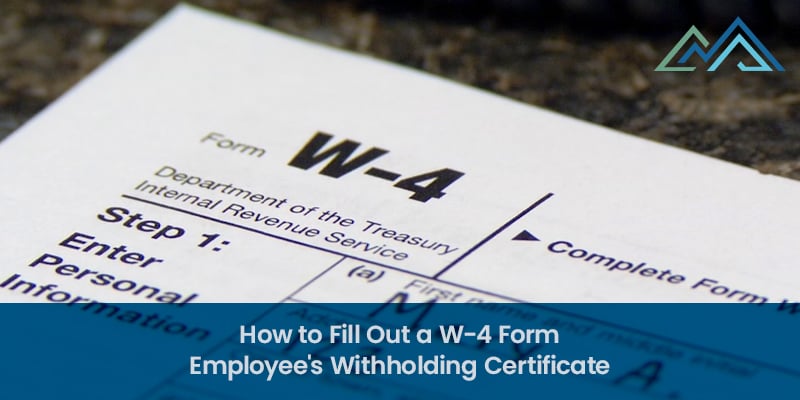One of the steps involved in properly filing and paying your taxes is filling out a W-4 form to give to your employer. Many people make mistakes that result in improper withholdings, which can lead to an unexpected tax bill at filing time or a large refund, neither of which is ideal.
At CMP, we assist our clients with every aspect of tax planning and filing, including the proper completion of W-4 forms. We’ve created this brief guide to walk you through the process and minimize the risk that you’ll make mistakes with your federal income tax withholding. Here’s what you need to know.

How to Correctly Fill Out a W-4 Form
There are five steps involved in completing your W-4 form. In this section, we’ll walk you through each section with specific instructions on what to do if you are Single, Married Filing Separately, Married Filing Jointly, Head of Household, Claiming Dependents, or you’re under 18 or a student. In many cases, the instructions are the same, but we’ll point out differences where they exist.
Keep in mind that the information you enter on your W-4 form is what your employer and their payroll provider will use to determine how much money to withhold from your paycheck. You want to get it right, so be sure to read these instructions and follow them.
Step 1 (Personal Information)
Step 1 is to fill in your personal information. The information in this section includes the following things.
- Your legal name (What is on your social security card)
- Your address
- Your Social Security Number
- Your filing status
The last item is part of your employer's use to determine your accurate withholding. You can choose from Single, Married Filing Separately, Married Filing Jointly, Qualifying Surviving Spouse, or Head of Household.
You may want to consult with an experienced tax professional to determine the proper filing status. The basic information in this section is the same regardless of which filing status you choose, and you’ll claim dependents later in the process.
Step 2 (Multiple Jobs or Spouse Works)
If you have more than one job, whether a traditional job or self-employment income from a side gig, you’ll need to provide estimated taxable income from all employment in this section of your W-4.
Let’s start with spousal income. If you’re married, filing jointly or separately, you’ll need to provide some information about your spouse’s income. You can use an online estimator if you prefer not to provide specific details. This option is the best choice if you have a self-employed income. Its purpose is to ensure that you won’t owe money when the time comes to file your tax return.
Another option is to use a worksheet attached to your W-4. If you select this method, then you’ll need to provide details about each job in your household for both you and your spouse.
The final method is to check the box to have your employer withhold taxes at the default rate. This method may result in more or less withholding than you need. You want to maximize your paycheck while making sure the tax liability is covered for the year.
The methods for listing income are the same regardless of your filing status. If you’re single or filing as a Head of Household (unmarried and pay more than half the costs of keeping up a home for yourself and a qualified individual), you won’t need to worry about anybody’s income other than your own. Filing as a Qualifying Surviving Spouse is something you can do if your spouse passed away and you didn’t remarry in the same year. This status allows you to file jointly with your deceased spouse. If they had income in the filing year, you’ll need to disclose it in this section.
Step 3 (Claim Dependents)
The third step is where you’ll claim dependents. Dependents may be any of the following people.
- Qualifying children under 19
- Qualifying children under 24 if they are full-time students
- Qualifying children of any age if they are permanently and totally disabled
- Qualifying relatives
In order for a qualifying relative to be claimed as a dependent, you must be supplying at least 50% of their annual support, and the dependent has less than $4,700 of gross income. Some examples of relatives include parents and grandchildren.
If you’re single or filing as a Head of Household, you’ll claim all dependents here, and note if you’re planning to claim any child-related tax credits. If you’re married, you should coordinate with your spouse to determine who will claim child-related tax credits since only one of you will do so.
This is also the section where you’ll claim any other tax credits you qualify for. You can read the full instructions on the IRS website.
Step 4 (Other Adjustments)
Section 4 of the W-4 form is your final spot to note any other adjustments to your withholding. Here are the things you should list in this section.
- Other income not disclosed in Section 2
- Deductions if you plan to itemize instead of taking the standard deduction
- Extra withholding, which you might need if you owe back taxes
If you are exempt from federal taxes because you didn’t owe taxes in the previous year, and you expect that you won’t owe federal taxes for the current year, then write EXEMPT in the spot below Step 4c. We rarely recommend this option because this results in no tax withheld to go toward your tax liability.
Step 5 (Sign the Form)
The final step is to sign and date your form. In other words, the hard part is over! Don’t sign your form unless you’re sure that all the information is accurate.
Keep in mind that you can change your W-4 at any time during the year, and you should if your filing status or income changes.
FAQ About W-4 Form Employee’s Withholding Certificate
Here are some of the most frequently asked questions about the W-4 Form Employee’s Withholding Certificate.
What is the W-4 form?
The W-4 Form is the form that your employer uses to determine how much federal tax to withhold from your paycheck. Federal taxes include both income tax and payroll taxes, which combine Social Security and Medicare taxes.
Your employer will require you to complete Form W-4 when you’re hired. You should review your Form W-4 regularly and make any changes needed to ensure that your withholding is correct and that you’re accurately representing your tax liability.
Who needs to fill out a W-4 form?
Anybody who has a job where they receive a regular paycheck from an employer needs to fill out Form W-4. That includes full-time and part-time work. It doesn’t include self-employment income.
Self-employed people need to track and pay their taxes, usually on a monthly or quarterly basis. They’ll fill out a W-9 form to give to anybody who hires them, but no taxes are withheld.
When should the W-4 form be filled out?
Your employer should provide you with Form W-4 to complete when you’re hired. It’s important to return the form immediately. That way, your employer will know how much tax to withhold, and you’ll be protected from over underpaying your taxes.
Remember that if you’re self-employed but also have a job with an employer, you’ll need to fill out Form W-4 for your employer while keeping your self-employment situation in mind. Many self-employed individuals prefer to have an employer withhold additional taxes to cover their self-employment income.
Why is it important to fill out the W-4 form accurately?
Filling out Form W-4 correctly is important for several reasons.
- It protects you by ensuring that the proper amount of federal tax is withheld from your paycheck each pay period.
- It means you won’t be giving too much money to the government. Instead, you’ll be keeping it in your pocket, where it can do you some good.
- It also means you won’t be surprised to learn you owe taxes when the time comes to file.
The key takeaway here is that accuracy is essential when completing your W-4 form. It means your employer won’t be withholding too much or too little. You’ll be able to predict what you owe and be shielded from any surprises when tax time rolls around.
When should you change your W-4 form?
The only time your employer will ask you for a W-4 form is when you’re hired. If you have a proactive HR person, they may prompt you to change your W-4 form if they know you’ve had a change of marital status or had a baby. But not every employer will do so.
It’s your responsibility to change Form W-4 whenever your financial circumstances or filing status change. Here are some circumstances when you should complete a new Form W-4.
- You get married or divorced.
- You have a baby.
- You adopt a child.
- One of your children graduates from college.
- You take in an aging parent.
- Moved to a new address.
Anything that might change the amount you need to withhold requires a new Form W-4. We suggest reviewing your W-4 annually to ensure the information is still accurate.
Final Thoughts on Completing the W-4 Form for Accurate Tax Withholding
Filing Form W-4 accurately is your responsibility as a taxpayer. The information you provide will allow your employer to withhold the proper amount of federal taxes from your paycheck. It will also protect you from overpaying or underpaying, meaning you won’t have any surprises at tax time.
The tax pros at CMP are here to help you with tax planning, including the proper completion of your W-4. Read about our income tax services and schedule a consultation today.

















